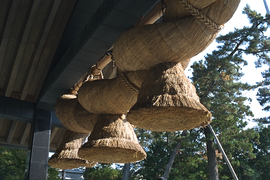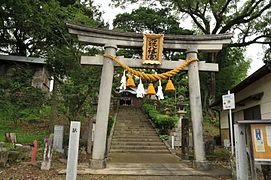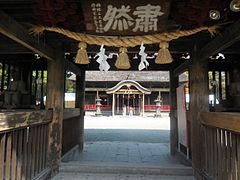Shimenawa
| Shimenawa | |
|---|---|
| しめ縄 | |
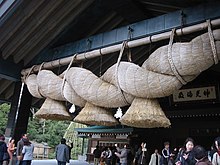 | |
| Material | Hemp fiber/Straw |
| Present location | Japan |
| Culture | Shinto |
Shimenawa(Tiêu 縄/ chú liền 縄/ bảy mươi lăm tam 縄,lit. 'enclosing rope')are lengths of laidricestraworhemp[1]ropeused forritual purificationin theShintoreligion.
Shimenawavary in diameter from a few centimetres to several metres, and are often seen festooned withshide—traditional paper streamers. A space bound byshimenawatypically indicates asacredor ritually pure space, such as that of aShinto shrine.[2]Shimenawaare believed to act as a ward againstevilspirits, and are often set up at aground-breaking ceremonybefore construction begins on a new building. They are often found at Shinto shrines,toriigates, and sacred landmarks.
Shimenawaare also placed onyorishiro,objects considered to attract spirits or be inhabited by them. These notably include being placed on certain trees, the spirits considered to inhabit them being known askodama.Cutting down these trees is thought to bring misfortune. In the case of stones considered to be inhabited by spirits, the stones are known asiwakura(Bàn tòa / nham tòa).[3]
A variation of theshimenawaare worn insumo wrestlingbyyokozuna(grand champions), during the entrance ceremony to debut as grand champion rank. In this instance,shimenawaused byyokozunaare seen as being livingyorishiro(a vessel capable of housing a spirit, known asshintaiwhen inhabited by a spirit), and are therefore visually distinguished as "sacred".
Shinto
[edit]Shimenawaoriginate in Shinto mythology as a hallowed sacrifice related to the Japanese god calledkami,and are used in various Shinto ceremonies. Aboriginal people in Japan have respected and reveredshimenawasince ancient times.[citation needed]
Origin ofshimenawa
[edit]
The prototype ofshimenawain Shinto is a rope ofAmaterasu,Japan's "Heaven-shining greatkami".[4]According to "A popular dictionary of Shinto", Amaterasu hid in a cave calledAmano-Iwatoafter an argument with her brotherSusanoo.[4]Therefore, the entire universe lost its luster.[5]Other deities tried numerous ways to attract Amaterasu out of the cave.[5]At the moment that Amaterasu left the cave, thekamiFuto-tamaused a magical rope that drew a line of demarcation between her and the cave, to avoid her returning to the cave.[4]The rope became known as ashimenawa.Because of theshimenawa,the universe returned to its previous state.[5]
Shinto shrines
[edit]
Shimenawaand nature have been a hallmark of Shinto shrines since in early times. The shrine in Shinto is a place forkami.[6]Local people held rituals in shrines. Early shrines were not composed of classical buildings,[6]with rocks, plants andshimenawainstead marking their boundaries,[6]as part of the Shinto respect for nature. InShinto,all the sacred objects and nature were personified.[6]Even a sword from a deceased Japanese warrior could be seen as the god because of its internal spirit and sense of awe.[7]In modern-day society, there are still some sites that useshimenawato demarcate boundaries, such as theNachi FallsinKumano.[6]A rock inIse Bayis still connected byshimenawaas well.[6]
Types
[edit]
Shimenawausually appear in a shape similar to a twisted narrow rope with various decorations on it.[4]Zig-zag paper and colorful streamers calledshidecommonly decorateshimenawa.[4]The size ofshimenawadiffers from simple to complicated. In shrines, they are usually tapered and thick with a diameter of 6 ft (1.8 m).[4]
Decorations
[edit]Shimenawaare decorated differently depending on the intended blessing and meaning.
- Daidai:a kind of bitter orange used to decorateshimenawa.This combination is seen to bring good fortune and prosperity.[8]
- Goheiorshide:folded white paper which stands for lightning, a symbol of fertility.[9]
- Pine twigs: using pine twigs to decorateshimenawahas a meaning of healthy growth for the next generation, as well as longevity of the elderly.[8]
Biggestshimenawain Japan
[edit]
The biggestshimenawain Japan is located atIzumo Taisha Grand Shrine,[8]which occupies over 27,000 m2(290,000 sq ft) of land in Japan. Theshimenawais 13.5 m (44 ft) in length and 8 m (26 ft) in width and was made by more than 800 indigenous people in Japan.[8]
Use
[edit]In Mountain Opening Ceremony
[edit]
Shimenawaare used in Japan's Mountain Opening Ceremony, which is held every May 1.[5]There are over 100 Shinto believers who participate in this ceremony.[5]It is a 2-hour journey that they climb from Akakura Mountain Shrine to Fudō Waterfall.[5]The overall purpose is to carry theshimenawaand fix it between two towering trees.[5]When the ceremony is finished, people get together and celebrate.[5]
In New Year's Celebration
[edit]In Japan's New Year celebration, ornaments such asshimenawadecorate every household. During this time period, local residents usually hang it on the door in order to drive away evils.
Shimenawaare used inHadaka Matsuri,Japan's Naked Festival.[4]This festival has been held during the New Year period for more than 500 years.[4]The festival's participants, who are all young men, wear nothing but afundoshiin cold weather in order to show their strength and manliness.[4]It also includes various activities such as 'jostling, climbing fighting with a wooden ball' as well as being sprayed with water.[4]Sometimes these festivals are held in Shinto shrines.[4]The participants putshimenawaon the roof to wish them good luck for the upcoming year.[4]Shimenawaare presented to thekamias a sacrifice in the shrine on New Year's day.[4]
In sumo
[edit]
Sumo,Japan's traditional national sport,[4]still involves some elements of Shinto.[4]Sumo matches are held in Shinto shrines, where the arena is demarcated byshimenawa.[4]Moreover, the grand champion (whose name, Yokozuna, means "horizontal rope" and refers to theshimenawa) wearsshimenawaaround his waist when making his entrance to the ring in a ceremony calleddohyo-iri.[10]
Construction
[edit]Material and preparation process
[edit]
Hemp fiberis the basic material used in the production ofshimenawa,and has been used since ancient times.[10]In Shinto, hemp is regarded as a sacred food with a meaning of purity and fertility.[10]After theCannabis Control Actof 1948, when the growing of hemp was banned,[10]straw began to be used instead as the raw material ofshimenawa.[11]During the process of production, the straw stems are harvested between 70 and 80 days of growth, as beyond this, the quality of the fibre decreases as the plant starts to produce its seeds.[11]After theshimenawastraw is collected by machine, it is heated for more than 10 hours, to avoid the stems being dried by the sun.[11]The best stems are then chosen by hand in order to createshimenawa.[11]
Related objects
[edit]Heihaku
[edit]Heihaku(also calledmiteguraorheimotsu), a vertical wooden stick decorated withshide,cloth or metal calledgohei,usually in red or white, which is used priests in Shinto.[4]People putheihakuin front ofhondendoors.[4]In a procession calledshinkō-shiki,heihakuare seen as a sacrifice for the gods or a symbol of the existence of the gods.[4]In ancient times, people offered cloth to the Shinto shrines, similarly to today's processions.[4]Heihakuare also sometimes used in the wayshideare.[4]The stripes can also hang on theshimenawa.[4]
Himorogi
[edit]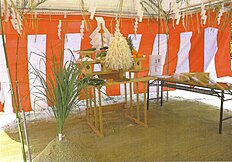
Himorogiare the sacred spaces delimited byshimenawa,[4]which sometimes feature acherry blossomtree surrounded by green plants appears, symbolising the seat of the gods.[4]
Kazari
[edit]Likeshimenawa,kazariare also a New Year's decoration in Japan,[4]consisting of ashimenawadecorated with items related to rice like rice-cakes.[4]The purpose of thekazariis to bring good fortune to people.[4]
Kamidana
[edit]
Kamidanaare a reduced version ofshimenawaused in daily life,[4]and are thought to control rice, salt, and water which could bring people good luck.[4]Therefore, it always appears in the business area such as restaurants as well as conventional industries.[4]Places like the police stations and board ships will also featurekamidana.[4]
Raijin
[edit]
Raijinis thekamiof thunder who also has power over drought.[4]According to "A popular dictionary of Shinto", there is a custom in Japan which talks aboutshimenawaand Raijin.[4]Local residents in Japan'sKantōarea put ashimenawabetween green bamboo after a bolt of lightning appears on the planted rice field out of gratitude to Raijin.[4]
Shinboku
[edit]Ashinbokuis a sacred tree located in a Shinto shrine sometimes indicated byshimenawa.[4]It also be seen as a god'sshintai.[4]These trees surrounding the shrine are seen as part of the shrine itself.[4]
Torii
[edit]
Toriiare an archway composed of two round posts and two upper cross-beams.[4]The ends of the cross-beams are typically curved, which is a symbol of a style calledmyōjin.[4]There is an under-cross-beam just below the top individually.[4]
Toriifirst appeared in Japan at the time Chinese culture andBuddhismwere introduced,[4]though their exact origin, including the origin of their shape and name, is unknown;[4]some researchers believe the nametoriito have originally come fromSanskrit.[4]
With the exception of the cross-beams, people also useshimenawato decoratetorii.[4]The type oftoriiusing onlyshimenawaas cross-beams is known asshimenawa torii,which consist of only two posts and ashimenawa;thesetoriiare intended to be temporary instead of permanent.[4]
In Japan, there are more than 20 different kinds oftorii,varying from simple wood constructions to those made of concrete gates, typically used as gates to Shinto shrines.[4]The style oftoriiis not strictly based on the style of shrine, and there could be more than one style oftoriiin one shrine.[4]
Similar toshimenawa,toriialso have meaning in Shinto, representing a gate to the world, people, or any relationship.[7]The purpose oftoriiandshimenawais the same, in bringing lost people to thekami-filled world.[7]

In art
[edit]During the 2017Yokohama Triennale,Indonesian artist Joko Avianto's artwork, "The border between good and evil is terribly frizzy", was displayed in the center of the hall in theYokohama Museum of Art.[12]The name, taken from the quote "The border between good and evil is terribly fuzzy" by Czech novelistMilan Kundera,[12]changed 'fuzzy' to 'frizzy' because of the twisted,shimenawa-inspired shape of his artwork.[12]Avianto took the meaning ofshimenawato separate 'the sacred and the profane', or 'the ideal and the secular',[12]as inspiration in his work, using it to symbolise the boundary between 'the earth and heaven'.[12]
Shimenawaproduction in Taiwan
[edit]
Taiwan'sMiaoli Countybegan to produceshimenawafor export to Japan in 1998.[11]In the late 1990s, Japanese manufacturers visited Taiwan and found the high quality of straw as well as the relatively low cost of producing it.[11]However, as there were no local residents who knew how to makeshimenawa,[11]the Japanese started to provide free classes for them to study the skills for producingshimenawa.[11]Theshimenawaindustry in Taiwan developed rapidly,[11]with many largeshimenawafactories appeared in Taiwan in the late 1990s. However, due to industrial disruption, most factories were forced to shut down a few years later, and only one factory was left to continue production.[11]Other remaining factories chose to hand over the work to otherSoutheast Asiancountries, particularlyVietnam,for a lower cost production.[11]Later in 2005, a large number ofshimenawaorders were transferred back to Taiwan because buyers in Japan found that the quality ofshimenawaproduced in Vietnam was poorer compared to those produced in Taiwan.[11]
The craftsmen in Taiwan harvest the straw to makeshimenawa,while Japanese manufacturers provide samples or finished products to the customers according to their orders.[11]
Image gallery
[edit]See also
[edit]- Kamidana,household Shinto shrines
- Kanjo Nawa– a custom utilizingshimenawa
- Kumihimo,traditional Japanese braided cord
- Saekki
References
[edit]- ^"Mie gov't rejects cannabis cultivation request for Shinto rituals".Japan Today.Archived fromthe originalon 2017-01-09.
- ^Cf. Kasulis (2004:17-23).
- ^"Shimenawa & Rock",More glimpses of unfamiliar Japan,Thursday, March 18, 2010
- ^abcdefghijklmnopqrstuvwxyzaaabacadaeafagahaiajakalamanaoapaqarasatauBocking, Brian (1995).A Popular Dictionary of Shinto.Richmond, Surrey, U.K.: Curzon Press.
- ^abcdefghSwanson, Paul L (2004-05-01)."Review of: Ellen Schattschneider, Immortal Wishes: Labor and Transcendence on a Japanese Sacred Mountain".Japanese Journal of Religious Studies.doi:10.18874/jjrs.31.1.2004.232-233.ISSN0304-1042.
- ^abcdefEvans, Marcus (2014-05-01)."Shinto: An Experience of Being at Home in the World With Nature and With Others".Masters Theses & Specialist Projects.
- ^abcKasulis, Thomas P. (2004-08-31).Shinto.University of Hawaii Press.doi:10.1515/9780824864309.ISBN978-0-8248-6430-9.
- ^abcdForlano, Laura; Steenson, Molly Wright; Ananny, Mike, eds. (2019).Bauhaus Futures.The MIT Press.doi:10.7551/mitpress/12044.001.0001.ISBN978-0-262-35492-9.S2CID239320625.
- ^Jiao, Yupeng (2020-11-17)."Rural Wandering Martial Arts Networks and Invulnerability Rituals in Modern China".Martial Arts Studies(10): 40.doi:10.18573/mas.109.ISSN2057-5696.
- ^abcdPrice, Stephanie (2020-09-11)."Cannabis, hemp, CBD: the Japanese cannabis landscape".Health Europa.Retrieved2020-11-17.
- ^abcdefghijklmChina (Taiwan), Ministry of Foreign Affairs, Republic of (2009-02-01)."Hanging in There".Taiwan Today.Retrieved2020-11-17.
{{cite web}}:CS1 maint: multiple names: authors list (link) - ^abcde"Joko Avianto at the Yokohama Triennale 2017. Nafas Art Magazine".universes.art.Retrieved2020-11-17.
Further reading
[edit]- Kasulis, Thomas P. (2004).Shinto: The Way Home.University of Hawaii Press.ISBN0-8248-2794-5.
External links
[edit]- "Shimenawa"inEncyclopedia of Shinto


